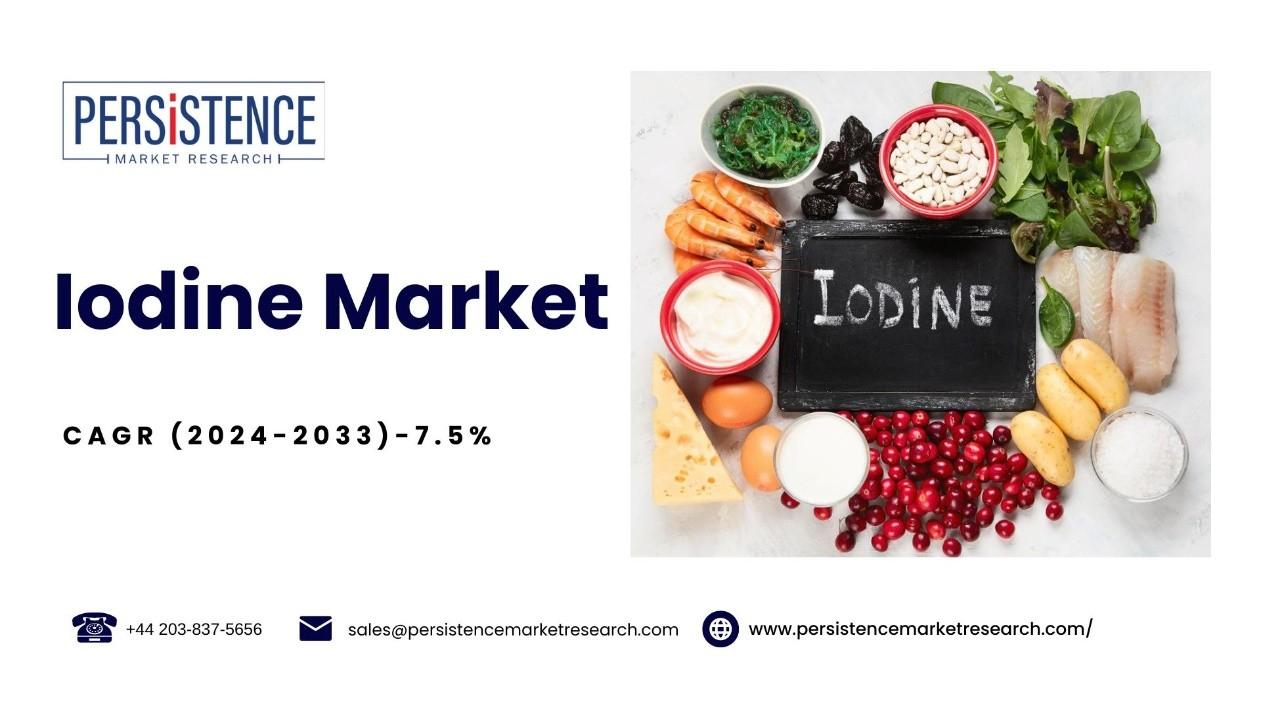Iodine Market: Size and Growth Analysis with Future Projections
According to Persistence Market Research, the global iodine market recorded a 103.1% Y-o-Y growth in 2022 and is estimated to be valued at US$ 3.6 billion in 2024. The market is projected to reach US$ 6.9 billion by the end of 2033, expanding at a noteworthy CAGR of 7.5% over the next ten years. Iodine, a nonmetallic element and the heaviest halogen in the periodic table, is found in small amounts in many natural sources, including brines and seaweeds. It is used in analytical chemistry, photography, and medicine, with the radioactive isotope I-131 being particularly notable for its medical applications. Iodine is a dark crystalline solid that changes to deep violet when heated and produces a pungent vapor. Consuming iodine is crucial for maintaining optimal mental and physical development. Iodine deficiency can lead to disabilities and disorders, including goiter, hypothyroidism, cretinism, abortion, stillbirth, mental retardation, and psychomotor defects. These issues are preventable with adequate iodine intake, making it essential for individuals of all ages. Iodine deficiency is the leading cause of preventable brain damage globally, with children in iodinedeficient areas having an average of 13.5 IQ points less than those in iodine-sufficient areas. Chile and Japan are leading producers of iodine, accounting for more than 90% of global production. The top five manufacturing companies in the world hold a 60% to 65% market share in 2024. The market is estimated to create an absolute incremental opportunity of US$ 3.5 billion from 2024 to 2033. Sales of iodine are driven by increasing demand for alcohols, ketones, and other organic acids, which are widely used in various chemical and product manufacturing. Overall, iodine is a crucial element with numerous applications in industries such as medicine, chemical production, and photography, and it is essential for human health. Iodine deficiency can lead to significant health problems. The market size in 2023 was US$ 3.4 billion, with an estimated value of US$ 3.6 billion in 2024, and a projected value of US$ 6.9 billion by 2033, reflecting a CAGR of 7.5%. The collective value share of the top three countries in 2023 was 47.9%. From 2018 to 2022, the iodine market advanced at a CAGR of 32.1%, driven by a rapid increase in product prices and high demand. Limited supplies from leading countries led to a surge in demand and prices, with price volatility posing a significant threat to iodine manufacturers. From 2024 to 2033, the market is anticipated to progress at a CAGR of 7.5%, with new and innovative applications of iodine driving high demand globally.

Key Growth Drivers
1. Healthcare Applications:
o Thyroid Health: Iodine is crucial for the production of thyroid hormones, making it vital in the treatment of thyroid-related disorders and iodine deficiency. The rising prevalence of thyroid diseases globally is a significant driver of market demand.
o Medical Diagnostics: Iodine-based contrast media are extensively used in imaging techniques such as CT scans and X-rays, enhancing diagnostic accuracy and driving demand in the healthcare sector.
2. Nutritional Fortification:
o Iodized Salt Programs: Government initiatives worldwide mandate iodine fortification in salt to combat iodine deficiency disorders (IDDs), ensuring widespread consumption and steady market growth.
o Dietary Supplements: Increasing consumer awareness of iodine’s health benefits is boosting demand for iodine-enriched supplements, particularly in regions with low natural iodine levels.
3. Industrial Uses:
o Chemical Synthesis: Iodine is utilized as a catalyst in various chemical processes, including the production of specialty chemicals and pharmaceuticals.
o Electronics and Displays: Iodine compounds are essential in the manufacturing of OLED displays and other electronic components, highlighting its versatile industrial applications.
Regional Market Insights
Asia-Pacific:
o Dominates the global iodine market, driven by extensive iodized salt programs and expanding industrial applications in countries like China and India.
o Rapid industrialization, urbanization, and increasing healthcare expenditures are fueling demand across multiple sectors.
North America:
o Significant demand from the healthcare and pharmaceutical industries, supported by stringent regulatory standards ensuring the quality and safety of iodine products.
o The United States is a major consumer, with a focus on medical and dietary applications.
Europe:
o High awareness of iodine's health benefits drives demand in the pharmaceuticals and nutritional supplements sectors.
o Government regulations and public health initiatives support iodine fortification programs, contributing to market growth.
Latin America and Middle East:
o Emerging as promising markets with increasing healthcare investments and expanding consumer awareness of iodine's benefits.
o Government initiatives promoting iodized salt and food fortification are expected to boost demand in these regions.
Future Projections and Opportunities
The iodine market is poised for substantial growth, with several key trends shaping its future:
1. Technological Advancements:
o Innovations in iodine extraction and purification techniques are enhancing production efficiency and sustainability.
o Advanced processing methods are improving product quality, ensuring compliance with regulatory standards and meeting consumer expectations.
2. Sustainable Practices:
o Emphasis on environmentally sustainable production methods to minimize ecological impact and ensure long-term resource availability.
o Companies are investing in research and development to adopt green technologies and sustainable sourcing practices.
3. Market Consolidation:
o Strategic mergers, acquisitions, and partnerships among key players are reshaping the competitive landscape, enabling companies to expand their market presence and diversify product portfolios.
o Collaboration across industries and regions is fostering innovation and driving market expansion.
Leading Market Players
Prominent companies in the iodine market include SQM (Sociedad Química y Minera de Chile), Iofina, Cosayach, and Godo Shigen Co., Ltd. These industry leaders are focusing on enhancing production capacities, investing in research and development, and exploring new market opportunities to maintain competitive advantage.
Conclusion
The iodine market is on a robust growth trajectory, driven by diverse applications, regional expansion, and technological advancements. As demand continues to rise, industry stakeholders are presented with significant opportunities to innovate, expand, and contribute to global health and industrial development.
